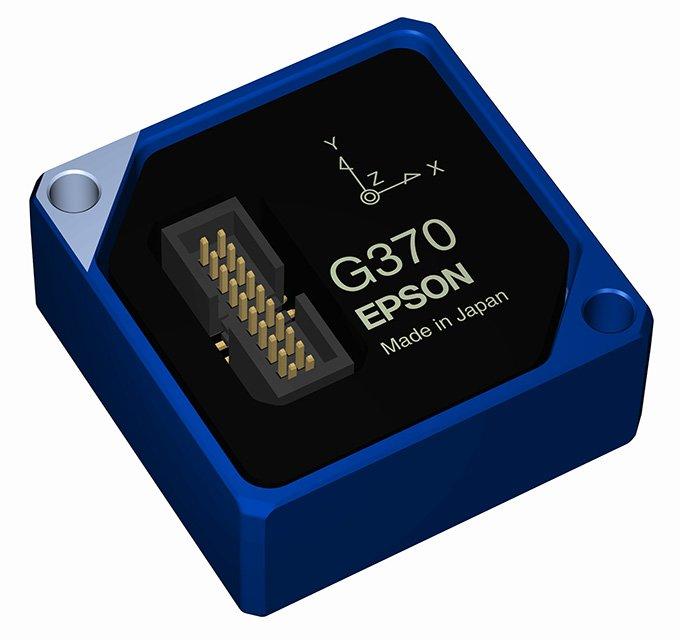Epson launched its first IMU in 2011. Since then, Epson IMUs have been used in a multitude of applications, earning an excellent reputation for outstanding performance and quality. Rapidly increasing demand from autonomous precision agriculture machinery, intelligent construction machinery and unmanned vehicle applications has fueled demand for high-accuracy positioning in a compact, cost-effective package. Epson’s new IMUs were developed to offer outstanding quality and productivity with the FOG2-class performance needed to realize practicable autonomous driving and navigation. In addition, the new IMUs maintain backward compatibility with the earlier M-G364 and M-G354, making it easy to upgrade performance.
Product Features
The M-G370 and M-G365
- Newly developed high-performance sensors that offer higher stability and lower noise in a wide dynamic range.
- Outstanding dynamic performance (scale factor non-linearity) for high-precision measurement, from static states to high-speed motion.
- Backward compatibility with the earlier M-G364 and M-G354, sharply reducing customer development costs and evaluation time.
- Low current consumption (16 mA, compared to 18 mA for the M-G364 and M-G354).
M-G370
- Epson’s top-of-the-line IMU provides FOG-class performance in a 1-inch package.
- Ideal for inertial navigation and other applications that require excellent position measurement accuracy, such as autonomous and unmanned applications.
- A newly-developed gyroscopic sensor3 provides sharply improved in-run bias instability4(0.8°/hr), angular random walk5, and noise performance.
- A newly-developed accelerometer provides dramatically improved in-run bias instability performance of 6 uG (compared to 50 uG for the M-G364) and initial bias error of 2 mg (1σ).
M-G365
- The standard for the next generation, this IMU has a new attitude angle output function and supports a wide variety of applications.
- An original high-speed DSP6 with an extended Kalman filter7 provides highly accurate real-time attitude angle output (Roll/Pitch/Yaw)8 at low power consumption.
- Eliminates the need for high-speed calculation of dynamic attitude angle on the system end, thus reducing system load and power consumption.
Application Examples
- Autonomous driving and unmanned control of precision agriculture and construction machinery.
- Unmanned equipment such as industrial drones, ground and subsea vehicles.
- Navigation systems (GNSS9, INS10, high-precision locators).
- Gimbaled camera and antenna stabilization.
- Vibration, angle and path measurement of industrial equipment and vehicles.
Glossary
1 An inertial measurement unit (IMU) is a device that is used for sensing inertial motion. It is comprised of 3-axis angular rate sensor and triaxial accelerometers.
2 A fiber optic gyro (FOG) is a type of gyroscopic sensor based on optical fiber and the properties of light interference that can be found in some high-performance IMUs.
3 A gyroscopic sensor (angular rate sensor) measures the rotation angle (angular rate) of an object versus a reference axis per unit of time.
4 Gyro bias instability is a measure of random variation in gyro output bias as computed over a specified sample time and averaging time interval, the variation of the bias being characterized by 1/f noise density.
5 Angle random walk is a measure of random variation in gyro output bias as computed over a specified sample time and averaging time interval, the variation of the bias being characterized by random noise density.
6 A digital signal processor (DSP) is an arithmetic circuit for high-speed processing of digital signals.
7 The extended Kalman filter, which uses model-based estimates and actual observed values to sequentially calculate the most probable values, are used to more accurately predict information from observed values that include filter errors.
8 Orientation angle (roll, pitch, and yaw):
- Roll: Angle of rotation of an object along its longitudinal axis
- Pitch: Angle of rotation of an object along its lateral axis
- Yaw: Angle of rotation of an object along its vertical axis
9 A global navigation satellite system (GNSS) is a satellite system that is used to pinpoint a geographic location anywhere in the world.
10 Inertial navigation system (INS)
About Epson
Epson is a global technology leader dedicated to connecting people, things and information with its original efficient, compact and precision technologies. With a lineup that ranges from inkjet printers and digital printing systems to 3LCD projectors, smart glasses, sensing systems and industrial robots, the company is focused on driving innovations and exceeding customer expectations in inkjet, visual communications, wearables and robotics.
Led by the Japan-based Seiko Epson Corporation, the Epson Group comprises more than 80,000 employees in 86 companies around the world, and is proud of its contributions to the communities in which it operates and its ongoing efforts to reduce environmental impacts.
Epson Europe Electronics GmbH is a marketing, engineering and sales company and the European Headquarters for electronic devices of the Seiko Epson Corporation, Japan. Since 1989 headquartered in Munich/Germany with 50 employees, Epson Europe Electronics GmbH has several European sales representatives and has a European-wide network of distributors. Epson Europe Electronics provides value added services for Semiconductors, Sensors, Sensing Systems and Timing Devices targeted to all markets like industrial, automotive, medical and communication. Epson products are recognized for energy saving, low power, small form factors and rapid time to market. Information about Epson Europe Electronics GmbH is available in the Internet under www.epson-electronics.de
Epson Europe Electronics GmbH
Riesstraße 15
80992 München
Telefon: +49 (89) 14005-0
Telefax: +49 (89) 14005-110
http://www.epson-electronics.de
![]()
